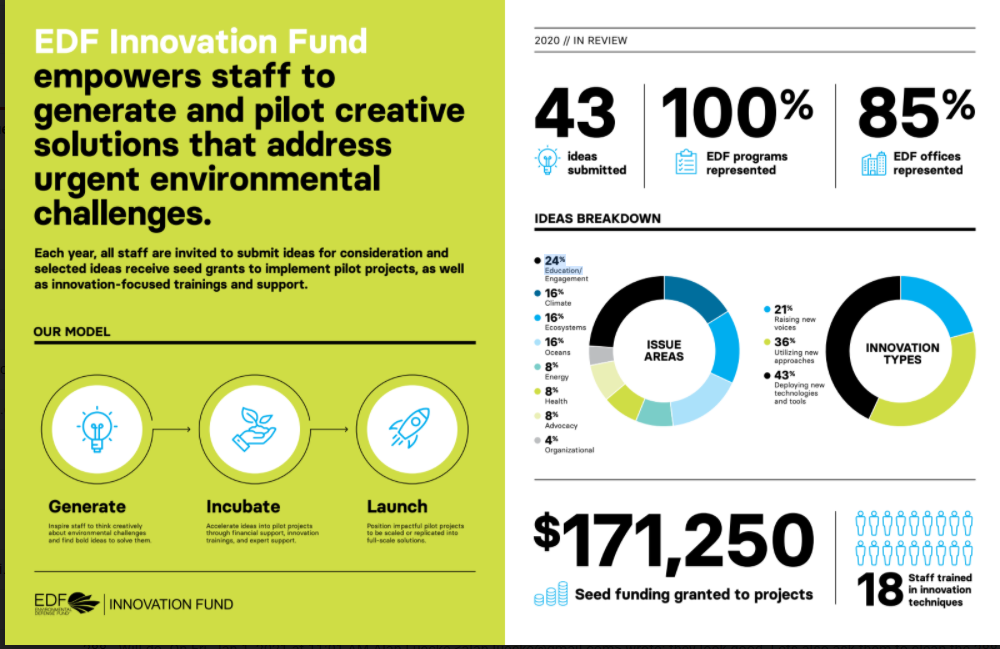4 guiding principles to foster environmental innovation in companies
Innovation funds and labs have long been in practice. Private companies have used various vehicles to spark innovation and incubate new products or services for decades.
Today we’re watching as environmental challenges become more severe, urgent and prolific. Pressure is on to find solutions and deploy them more quickly than ever before. We must take risks, we must embrace failures and we must drive environmental innovation. That’s how we will unlock the creative solutions needed to address the climate crisis.
One of the most powerful ways that companies can foster innovation is by looking within, to their employees. Empowering staff to generate and pilot solutions can be done by administering internal, flexible grants for exploring new ideas, creating prototypes and running pilots with the potential to scale. Welcoming risk-taking ideas that embrace experimentation can have significant impact.

This year, Environmental Defense Fund tested the efficacy of such a program, launching our first ever Innovation Fund. In its first month, staff submitted 43 innovative ideas for environmental solutions. The caliber of ideas shows just how powerful cultivating internal entrepreneurship can be. Take these three ideas:
- An AI-driven listening and micro-targeting messaging campaign with social media influencers to raise consumer awareness around the equity issues when it comes to toxic chemicals in products marketed to women of color.
- Using Vehicle-to-Building technologies with electric school buses to provide emergency power to critical facilities in times of natural disasters.
- Pilot the use of environmental-DNA concentrations to rapidly characterize fish species mix in a catch and improve multispecies management in industrialized and developing nations’ fisheries.
As EDF built and rolled out this new Innovation Fund, we embraced four guiding principles that we believe all companies can follow to foster innovation — whether through an innovation fund or not.
1. Allow the time and mental space to explore.
Innovation doesn’t need a dedicated physical space, but it does need mental space and time. Ideas come sporadically — often while working on another project and separate from annual budgeting or fundraising plans. Organizations must allow employees to feel comfortable thinking beyond their workplan and spending time exploring new ideas.

2. Listen to all of your employees.
The new ideas we heard did not come from themed “innovation sprints” or guided sessions from innovation consultants. They came from us asking our staff, all of our staff, one simple question: what gaps or opportunities are you seeing in your work? We wanted to find ideas that aligned within existing strategies, not a new, trendy theme. And then we listened. In many organizations, idea funnels have become narrowed to only include the top of the organization. When in reality, the ideas that address the human-centered needs of a challenge often come from those closest to the field work and seamlessly integrate into existing work.
3. See entrepreneurs, not ideas.
Innovation does not only mean new ideas. Innovation is a mindset and an approach to looking at challenges. One of the top reasons that innovation labs fail is that ideas get trapped inside of innovation labs and never connect back to the real world. Because of that, the role of an innovation fund should not be fixated on new ideas, but instead, empowering staff to become internal entrepreneurs, or, intrapreneurs. For those employees with a new idea, a large focus of EDF’s Innovation Fund is offering trainings and workshops to help them execute their idea, from design-thinking to prototyping to scaling, whether they’ve received a seed grant or not. Because even if this idea fails, we want staff to be able to act on the next idea in real time and without the need for an innovation fund.
4. Embrace risk and expect failures.
Not all of the ideas that receive funding from our Innovation Fund will succeed. In fact, if they all do succeed, this is no longer an innovation fund, it’s just another budgeting cycle. Part of innovation is experimenting and trying something new — whether it be a new tool, a new approach, a new audience, etc. — with the hope that those new ideas that do succeed will have a tremendous impact. Because of that, expectations with leadership and staff must be clear from the start that innovation funds and labs will be a place that encourages risk and understands the value in learning from failures.
As we grow EDF’s Innovation Fund, we’re looking to continue learning from others that are finding ways to innovate for the environment. Feel free to share your comments or get in touch with us at dhill@edf.org.
Connect with Daniel on LinkedIn.